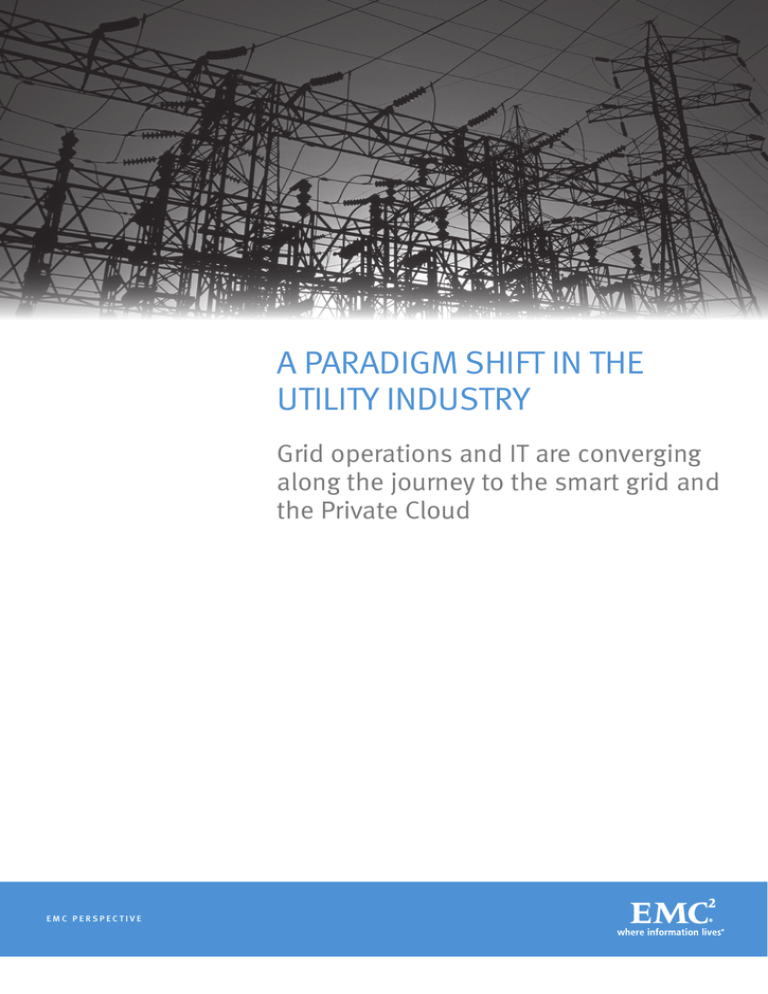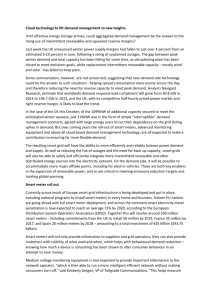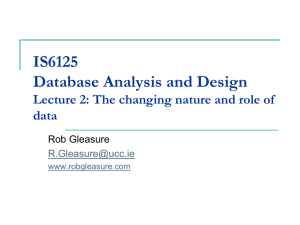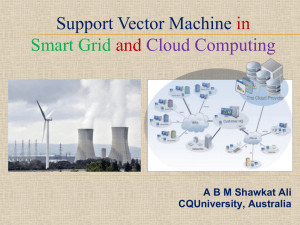
A PARADIGM SHIFT IN THE
UTILITY INDUSTRY
Grid operations and IT are converging
along the journey to the smart grid and
the Private Cloud
EMC PERSPECTIVE
“It’s no secret that the utility industry is undergoing radical change…the changes impacting
utilities as the most dramatic since the days of Edison.”
The industry has reached a critical juncture as a number of forces are converging, compelling
utilities to fundamentally change their business.
This white paper discusses the current state of the utility industry from a business perspective,
including drivers and trends. It also discusses the emerging convergence of IT and grid
operations, fueled by smart grid initiatives underway across the globe.
At its core, the smart grid is a system of two-way communication between end-consumer
and utility. It is the overlay of a network infrastructure on top of a more efficient electric grid
from generation through transmission and distribution (T&D) to the meter and into the home
or business. It is the beginning of new programs like demand response, distribution and
substation automation, wide area measurement systems, renewable and distributed generation, virtual power plants, home area networks and time-of-use pricing. Central to the
success of any of these programs is the ability to leverage new sources of information for
business value.
This paper further explains some of these new sources of information and introduces a
new model to manage the massive volumes: the private cloud. The private cloud is both an
end-state and a journey necessary to manage, protect, secure and extract value from data. It
is a journey expected to run—not in isolation, but in concert and support of—the operational
advancement realized via the smart grid.
UTILITY INDUSTRY: A BUSINESS PERSPECTIVE
The drivers and trends fueling the utility industry today are summarized below, ranging from
exponential data growth from new intelligent electronic devices like smart meters and synchrophasors to an aging workforce to threats of foreign espionage and terrorism to increasing regulatory constraints.
INDUSTRY DRIVERS AND TRENDS
Exponential data growth
Rising concerns on data security, protections, and management
Supply-side constraints
Demand exceeding supply; carbon legislation; renewables mandates
Aging workforce
Knowledge retention issues: -30 percent of the workforce retiring in next five years
Antiquated infrastructure
Most equipment is already past its current life expectancy
Public safety
Grid vulnerable to acts of terrorism and natural disasters
Increased urgency to “protect the grid”
Regulatory concerns
NERC-CIP; FERC; EPA; PUCs; data retention; energy efficiency; renewables
Economic loss
Outages cost U.S. businesses >$100B on average per year
Source: McKinsey, Gartner, Forrester, EPRI, DOE, EMC
Utilities are facing a turning point as all of these forces are emerging simultaneously. Point
solutions will not be sufficient and instead a paradigm shift in business model must be
undertaken. This shift has manifested itself in the smart grid.
According to the U.S. Department of Energy, the smart grid is the electric industry’s transformation from a centralized, producer-controlled network to one that is less centralized and
more consumer-interactive.2
The smart grid is also the beginning of IT and Operational Technology (OT) convergence.
“The utility industry has been talking about the fact that the lines are blurring between
OT and IT,” according to IDC.3
2
Patricia Graham, division vice president of information technology and CIO at CenterPoint
Energy agrees: “The operations side of the utility is becoming very IT-oriented, so information technology is suddenly playing a very big role in an area that until now has been
mechanical and manually intensive.”4
And to back it up with numbers: growth in IT spending among the U.S. utility industry will
grow 11 percent in 2010 year over year, compared to an average of 2.6 percent in all other
industries.5
Why?
“CIOs now have a seat at the executive table, due to the obvious demands smarter grids
place on operational aspects of the business and due to the need for business analytics.”6
INFORMATION IS A KEY ENABLER
Without information—and the appropriate level of investment in IT to extract value from
information—utilities will not realize maximum benefit from the smart grid, from increased
intelligence, to reduced operational expense, to deeper customer relationships to the
meter-to-cash process.
Information will:
•Power new pricing mechanisms
•Enable new customer programs like demand response and energy rebates via usage and
payment behavior analysis
•Facilitate operational efficiencies via more accurate load analysis and forecasting to reduce
the frequency of firing peak plants
•Provide more advanced guidance on the building and placement of renewable generation
•And more…
Perhaps even more importantly, information will be the key tool in customer education and
the key driver towards a shift in energy consumption behavior necessary for the success of
any smart grid program.
So how much new data are we talking about? And where is this data coming from?
3
The data will come from millions of new intelligent electronic devices installed along the grid
and a new network infrastructure to transmit the data from the endpoints back to the utility’s
data center. Below is a representative example of the types of devices and applications that
will generate data:
Time
0
200
400
600
800
1000
Annual Rate of Data Intake (TB)
Pike Research estimates 250 million new smart meters worldwide by 2015. This might even
be a low estimate, considering announcements like President Barack Obama’s goal of “40
million smart meters in American homes and businesses,” the United Kingdom’s initiative
to replace all 47 million electric and water meters with smart meters by 2020, the European
Union’s energy directive calling for 80 percent smart meter penetration by 2020, and China’s
plan to replace 300 million older meters.
Smart meters, in many instances, are already collecting interval data at hourly or 15 minutes
increments, and sometimes even more frequently for commercial and industrial (C&I)
customers.
When utilities move from monthly reads, to meter reads once every 15 minutes, they will see
an increase of about 3,000 times the amount of data.
Then enter in the data from the millions of new electronic devices being installed along the
grid above and beyond the meters at customer premises. According to the U.S. Department
of Energy’s Office of Electric Delivery and Energy Reliability, “Presently, only 30 percent of all
power generated uses power electronics somewhere between the point of generation and
end use. By 2030, 80 percent of all electric power will flow through power electronics.”
These new devices include smart sensors on transformers and substation devices, intelligent
relays and circuits, in-home devices like smart thermostats and smart appliances, electric
vehicles and synchrophasors along the grid, such as:
• The Western Electricity Coordinating Council (WECC) has established the Western Interconnection Synchrophasor Program (WISP). The current WISP project will require installing
150 synchrophasors across eight utilities, each providing data samples at up to 60 times
per second.12
• The PJM Interconnection currently has 14 phasors installed and has a plan to expand to
more than 90. “With the data it can gather from enhanced coverage, PJM can then, across
a three-year timeframe, work to mine the imperative signals—how does a normal situation
compare to an abnormal one for instance—that help provide member operators with the
data necessary to improve reliability, better integrate renewables and intermittent generation into the mix, and more.”13
To manage this explosion of data, utilities will need to transform their operating paradigms,
including not only the technology, but also the people and processes.
4
THE PRIVATE CLOUD
The private cloud enables IT organizations to become internal service providers to providing
IT resources to their various constituencies as they need it. The cloud offers tremendous
flexibility. At its core, the cloud offers scalable, readily available computing and storage
environments that can be applied simultaneously to many users. In addition, because
systems are managed centrally, security controls can be applied more consistently across
the environment and infrastructure.
The power of the cloud’s flexibility is also seen in dynamic provisioning—enabling organizations to quickly scale up for peak demand periods or scale down during lower usage periods.
Cloud models ensure greater utilization of resources and IT assets, thereby reducing overall
costs while providing users the services they need.
“Clouds are generally run differently than traditional IT,” says Chuck Hollis, EMC’s Vice President – Global Marketing Chief Technology Officer. “The first thing you notice is that there are
far fewer people required to run a given environment of a certain size because the supporting
technology platform is relatively standardized and uniform. Compare this with a traditional IT
operation that might have different kinds of servers, networks, operating systems, storage, etc.
EXAMPLE STORAGE REQUIREMENTS FOR AMI
2,880x
200
AMI Storage (TB)
249.0
Me
te
rD
at
aS
to
ra
ge
Gr
ow
th
250
150
720x
100
62.2
120x
50
0
30x
0.1
2.6
1/month
1/day
10.4
4/day
1/hour
4/hour
Meter Reading Frequency*
Backup
Data Warehouse
Primary DR
Primary
*Source: EMC
Based on 1M residential subscribers
Dr: Disaster Recovery
Backup includes weekly, monthly and quarterly fulls and daily incrementals
“This standardization of platform makes standardization of process that much easier. Standardized processes make automation much easier and—if done right—require an absolute
minimum of IT interaction. Because it is all about the processes, work is organized using a
process- or service-centric model, rather than the standard ‘cylinder of excellence model’
we usually find in IT, with server, network, storage, database, etc.”
5
To move toward this new informational paradigm as an enabler for the smart grid, EMC has
established and defined a three-step process:
1.IT Production
2.Business Production
3.IT-as-a-Service (ITaaS)
Cost Efficiency
Quality of Service
Business Agility
Stage
IT Production
Business Production
ITaaS
Ownership/Sponsorship
IT
IT/LOB
CIO
Business Value
CAPEX
OPEX
CAPEX
OPEX
Availability
Responsiveness
CAPEX
OPEX
Availability
Responsiveness
Compliance
Tim-to-market
Key capabilities
• Shared resource pools
• Elastic capacity
• Zero-touch infrastructure
• Increased control and service
assurance
• Self-definition
• Self-service
• Chargeback
Approaches
Reactive
Selective
Proactive
THE JOURNEY TO THE PRIVATE CLOUD
PHASE 1: IT PRODUCTION
The primary goal is to reduce internal IT costs via consolidation and virtualization. By virtualizing IT assets, organizations can consolidate servers, storage, networks, desktops and the
management of applications into pools of resources instead of separate silos of technology.
Greater degrees of automation, the ability to dynamically provision IT resources, and concepts
like chargeback and Fully Automated Storage Tiering (FAST),14 can be introduced.
Data center optimization is also a key component; consolidation and virtualization deliver
more efficient power and cooling as well as better utilization rates for storage and servers.
Consolidation and centralization make it easier to manage security controls, to apply consistent security technologies across the organization and to ensure the utility is meeting its
compliance obligations, like to FERC, NERC-CIP, and the EPA, among others.
PHASE 2: BUSINESS PRODUCTION
Once technology resources have been virtualized and consolidated, the IT organization can
proactively collaborate with the constituent business units to improve quality of service,
both via service-level agreements (SLAs) and ad-hoc requests. The IT organization and the
business units can also have greater insight into the particular resources consumed at a
given time for processes like chargeback and procurement.
PHASE 3: IT-AS-A-SERVICE
At this phase in the journey to the private cloud, the primary goal is to increase the agility of
the IT organization. Automation, federation, and self-service provisioning are key initiatives.
When infrastructure is virtualized and consolidated and automated processes are in place,
much of the pain of provisioning resources to enable business functions is removed. This
includes standing up new environments of storage, networks, servers, switches per business
unit, managing disparate silos of technology, procurement, accurate chargeback, worrying
about what data center or what location a particular device resides in, and the list goes on.
6
From a business perspective, the agility that the private cloud affords an IT organization
makes new initiatives much more palatable within a shorter timeframe, enabling IT to act at
the pace the business requires. In a utility context, this includes reacting to new initiatives
that will require significant data management investments, including data warehousing,
electric vehicles, renewables integration, virtual power plants, etc.
Private Cloud
App
App
App
App
App
Virtual
Applications Loads Loads Loads Loads Loads
Federation
Virtualized
Data Center
VMware vSphere = Cloud OS
Information Security
Internal Cloud
Cloud
Computing
External Cloud
UTILITY CLOUD PLANS TODAY
In a survey conducted by a leading market research firm of 177 utility representatives, 40
percent are either already using some form of cloud services or are currently evaluating. As
utilities move to AMI, 59 percent anticipated that their use of cloud services will increase.
In choosing which of the two cloud models, 29.7 percent said they would only use private
clouds and 41.6 percent said they would use a combination of private and public.
Which application will move to the cloud, private or public? 30.4 percent said only enterprise
systems and services but 26.6 percent said all systems and services are good candidates,
including the operational systems involved with the generation, transmission and distribution
of energy.
And who will be making the decisions? 50.5 percent said “the information technology department will make [purchasing] decisions in consultation with the operational departments” and
54.7 percent said IT would drive the “structure and design decisions.”15
These results point back to the roadmap strategy outlined above. Start internal with enterprise
applications and services. Consolidate, centralize, and virtualize. Then implement new
business processes at enterprise scale, and finally evolve to the as-a-service model,
enabling greatly enhanced IT agility.
Evaluate the benefits on the IT side of the house, with an eye toward future efficiencies by
bringing the benefits of the cloud to operational applications like SCADA, DMS, EMS, and
OMS and new applications like data warehousing, electric vehicles, demand response and
distribution, and substation automation.
ARE YOU READY TO TAKE THE JOURNEY?
The industry is changing; IT and grid operations are converging, and utilities are already
embarking down new initiatives like advanced metering infrastructure and wide area
measurement systems.
Are you ready to take the journey to the private cloud to enable the journey to the
smart grid?
7
Silverstein, Ken. “Identity Crisis: CIO Challenge.” IntelligentUtilityMagazine. May/June 2010. Vol. 2, Issue 3.
http://www.nxtbook.com/nxtbooks/energycentral/iu_20100506/#/32
1
“The Smart Grid: An Introduction.” United States Department of Energy. 2008. http://www.oe.energy.gov/
DocumentsandMedia/DOE_SG_Book_Single_Pages%281%29.pdf
2
Feblowitz, Jill, Rick Nicholson and Marcus Torchia. “ABB Acquires Ventyx – Convergence Between OT and IT
Just Got Closer.” IDC. May 06, 2010. http://www.idc-ei.com/getdoc.jsp?containerId=lcUS22333210&session
Id=B3F89046559176EA0B69905B4FB900B2
3
Silverstein, Ken. “Identity Crisis: CIO Challenge.” IntelligentUtility. May/June 2010. Vol. 2, Issue 3. http://
www.nxtbook.com/nxtbooks/energycentral/iu_20100506/#/32
4
Nicholson, Rick, et al. “North America Utility Industry 2010 Top 10 Predictions.” IDC.
Webcast. January 14, 2010.
5
Carson, Phil. “CIOs: Carbon Pricing, Renewables, Electric Vehicles.” RenewablesBiz.com. June 29, 2010.
http://www.renewablesbiz.com/article/10/06/cios-carbon-pricing-renewables-electric-vehicles
6
Gohn, Bob & Clint Wheelock. “Smart Electrical Meters, Advanced Metering Infrastructure, and Meter Communications.” Pike Research. Q4 2009.
7
“President Obama Announces $3.4 Billion Investment to Spur Transition to Smart Energy Grid.” White
House Press Release. http://www.whitehouse.gov/the-press-office/
president-obama-announces-34-billion-investment-spur-transition-smart-energy-grid
8
“UK energy smart meter roll-out is outlined.” BBC News. December 9, 2009. http://news.bbc.co.uk/2/hi/
business/8389880.stm
9
“European Commission smart grid task force sets goals.” SmartGridToday.com. November 10, 2009. http://
www.smartgridtoday.com/public/939.cfm
10
Baburajan, Rajani. “Cogo Expects Rapid Growth from Smart Meter Investments in China.” Smart Product
Ecosystem Connections. January 15, 2010. http://smart-products.tmcnet.com/topics/smart-products/
articles/72835-cogo-expects-rapid-growth-from-smart-meter-investments.htm
11
Carson, Phil. “Smart Tech Equilibrium.” IntelligentUtilityMagazine. May/June 2010. Vol. 2, Issue 3. http://
www.nxtbook.com/nxtbooks/energycentral/iu_20100506/#/32
12
Rowland, Kate. “PJM Takes Intelligence to Broader Level.” IntelligentUtilityMagazine. September/October
2009. Vol. 1, Issue 5. http://www.nxtbook.com/nxtbooks/energycentral/iu_20090910/index.
php?startid=38#/40
13
FAST: Introduced by EMC in 2010, FAST automates the tiering process within EMC’s storage arrays, leveraging Flash, Fibre Channel and SATA drives to place the right data on the right tier of storage at the right time,
depending on the business value of that data)
14
Causey, Warren B. and Bart Thielbar. “Cloud Computing Survey.” Sierra Energy Group and The Strategy,
Research & Analysis Division of Five Point Partners, LLC. May 21, 2010.
15
TAKE THE NEXT STEP
To learn more about how EMC can help you
on your journey to the private cloud, visit
www.EMC.com/smartgrid
EMC2, EMC, the EMC logo, and where information lives are registered trademarks or trademarks of EMC Corporation in the United
States and other countries. All other trademarks used herein are the property of their respective owners. © Copyright 2010 EMC
Corporation. All rights reserved. Published in the USA. 08/10 EMC Perspective H7368
EMC Corporation
Hopkinton, Massachusetts 01748-9103
1-508-435-1000 In North America 1-866-464-7381
www.EMC.com





